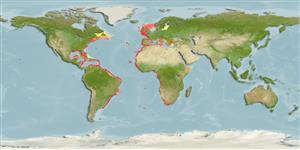>
Scombriformes (Mackerels) >
Scombridae (Mackerels, tunas, bonitos) > Scombrinae
Etymology: Sarda: Latin and Greek, sarda = sardine; name related to the island of Sardinia (Ref. 45335).
More on author: Bloch.
Environment: milieu / climate zone / depth range / distribution range
Ökologie
seewasser; brackwasser; ozeanodrom (Ref. 51243); tiefenbereich 80 - 200 m (Ref. 5377). Subtropical; 12°C - 27°C (Ref. 168); 62°N - 40°S, 98°W - 42°E (Ref. 54865)
Eastern Atlantic: Oslo, Norway to Port Elizabeth, South Africa. Also known from the Mediterranean and Black Sea. Western Atlantic: Nova Scotia, Canada to Florida, USA and northern Gulf of Mexico; then from Colombia, Venezuela, and south of the Amazon River to northern Argentina; apparently absent from most of the Caribbean Sea.
Length at first maturity / Size / Gewicht / Alter
Maturity: Lm 37.8, range 41 - ? cm
Max length : 91.4 cm FL Männchen/unbestimmt; (Ref. 168); common length : 50.0 cm FL Männchen/unbestimmt; (Ref. 168); max. veröff. Gewicht: 11.0 kg (Ref. 40637); max. veröff. Alter: 5 Jahre (Ref. 29114)
Rückenflossenstacheln (insgesamt): 20 - 23; Rückenflossenweichstrahlen (insgesamt): 15-18; Afterflossenstacheln 0; Afterflossenweichstrahlen: 14 - 17; Wirbelzahl: 50 - 55. Mouth moderately large. Laminae of olfactory rosette 21-39. Interpelvic process small and bifid. Body completely covered with very small scales posterior to the corselet. Swim bladder absent. Spleen large. Liver with elongate left and right lobe and short middle lobe. Oblique dorsal stripes with a greater angle than in other species of Sarda.
Epipelagic, neritic and schooling species that may enter estuaries. Known to be cannibalistic, adults prey on small schooling fishes, invertebrates like squid and shrimps and can swallow relatively large prey. Eggs and larvae pelagic (Ref. 6769). Utilized fresh, dried or salted, smoked, canned and frozen (Ref. 9987). Able to adapt to different temperatures 12° to 27°C and salinities 14 to 39 (Ref. 36731).
Collette, B.B. and C.E. Nauen, 1983. FAO Species Catalogue. Vol. 2. Scombrids of the world. An annotated and illustrated catalogue of tunas, mackerels, bonitos and related species known to date. Rome: FAO. FAO Fish. Synop. 125(2):137 p. (Ref. 168)
IUCN Rote Liste Status (Ref. 130435)
Bedrohung für Menschen
Reports of ciguatera poisoning (Ref. 30303)
Nutzung durch Menschen
Fischereien: hoch kommerziell; Sportfisch: ja
Tools
Zusatzinformationen
Download XML
Internet Quellen
Estimates based on models
Preferred temperature (Ref.
123201): 7 - 23.4, mean 10.7 °C (based on 346 cells).
Phylogenetic diversity index (Ref.
82804): PD
50 = 0.5312 [Uniqueness, from 0.5 = low to 2.0 = high].
Bayesian length-weight: a=0.00871 (0.00764 - 0.00993), b=3.06 (3.02 - 3.10), in cm total length, based on LWR estimates for this species (Ref.
93245).
Trophic level (Ref.
69278): 4.5 ±0.0 se; based on diet studies.
Generation time: 2.5 (1.4 - 3.1) years. Estimated as median ln(3)/K based on 14
growth studies.
Widerstandsfähigkeit (Ref.
120179): mittel, Verdopplung der Population dauert 1,4 - 4,4 Jahre. (K=0.13-0.24; tm=1; tmax=5).
Prior r = 0.57, 95% CL = 0.37 - 0.85, Based on 9 stock assessments.
Fishing Vulnerability (Ref.
59153): Low to moderate vulnerability (33 of 100).
Climate Vulnerability (Ref.
125649): Moderate to high vulnerability (48 of 100).
Nutrients (Ref.
124155): Calcium = 48.6 [29.8, 70.5] mg/100g; Iron = 3.05 [1.93, 4.90] mg/100g; Protein = 21.2 [20.2, 22.1] %; Omega3 = 0.438 [0.198, 0.939] g/100g; Selenium = 34.7 [24.6, 48.6] μg/100g; VitaminA = 9.6 [3.1, 34.2] μg/100g; Zinc = 0.505 [0.409, 0.700] mg/100g (wet weight); based on
nutrient studies.
